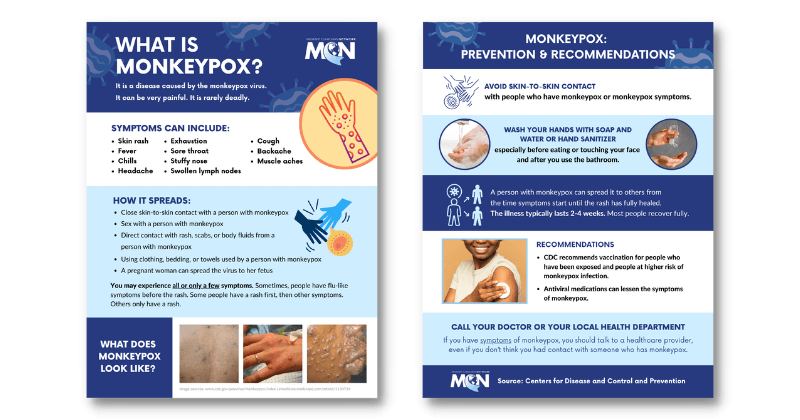Mpox

Updated September 12, 2022. For the most up-to-date information, see the CDC’s 2022 Outbreak Cases & Data page.
Monkeypox first emerged in the United States in May 2022, with a small number of confirmed cases. By September 2022, over 21,000 cases had been identified across the country. Clinicians serving migrant, immigrant, and marginalized communities need to be aware of several aspects of the growing outbreak:
Infection control: There has been at least one death of an immunocompromised patient in the US. Most infections have not been deadly, but are very painful and disruptive for patients. As with other viruses, the greater the spread, the more likely a mutation, which can lead to deadlier or more infectious strains. Many migrant and immigrant communities incorrectly believe that the virus is only circulating among LGBTQIA+ communities. While most of the cases are presently among men who have sex with men, the virus is not limited to those communities. Additionally, stigma may reduce awareness of spread within the larger community. Spread can occur with any exposure to monkeypox lesions. Those living in close-quartered communities who share towels or bedding that contain shedded virus are also vulnerable to monkeypox infection, as are workers who handle those towels and bedding.
Vaccine availability: A vaccination against Monkeypox is effective, but not widely available at this point. Many people who want the vaccine are unable to access it. As vaccines become available, building a vaccination strategy that centers health equity is essential. CDC’s Interim Guidance on Vaccination provides helpful considerations for health equity.
Stigma: Infection control and vaccine acceptance may both be negatively impacted by growing stigma around Monkeypox. Among certain migrant and immigrant communities, this stigma may be heightened. Emphasizing that anyone can contract Monkeypox (including those in laundry services in hotels and hospitals) and equipping these communities with culturally appropriate, accurate information on how to avoid infection are essential.
Resources:
As the outbreak grows, more resources have been developed to help clinicians and their patients get good information on Monkeypox.
Resources for Clinicians:
- CDC’s Interim Clinical Considerations for Monkeypox Vaccination
- CDC’s Clinician FAQs on Monkeypox
- APHA’s Monkeypox: The State of the Science, an archived webinar from August 2022
- MCN’s July 2022 FAQ for Clinicians on Monkeypox contains some basic information
Resources for Patients and Workers interested in more information:

MCN’s two-page low-literacy Monkeypox handout is available in English and Spanish.
- National Council for Occupational Health & Safety's Monkeypox: What Workers Need to Know resource is available in English and Spanish.
- NYC Department of Health's Guidance for How to Handle Laundry During Monkeypox for Commercial Settings in English and Spanish.
- CDC’s What to Do If You Are Sick resource page in English and Spanish.